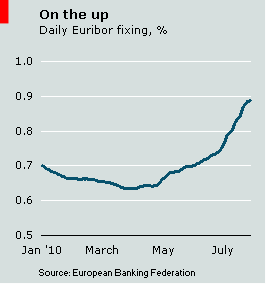You are currently browsing the tag archive for the ‘stress test’ tag.

Europe’s banking stress tests failed a test of their own on Monday. The cost of euro-denominated interbank borrowing continued to rise, approaching a one-year high.
The Euro Interbank Offered Rate, or Euribor, has risen every day since May 31st, even after the supposedly soothing news on Friday that only seven out of 91 banks failed stress tests conducted by the region’s banking authorities. When it comes to lending to each other, lenders remain wary.
The majority of data and analysis at Financial Services Briefing is available only to subscribers. Each week, a small share of content from the service is made available to non-subscribers.

In this test, the questions asked are as noteworthy as the answers received. In the months since the announcement that national and pan-European authorities would “stress test” 91 of the region’s banks, few details about the methodology used in the exercise were disclosed. Thus, when the results of the stress test were released on July 23rd, the assumptions used to gauge the health of banks were analysed as closely as the ultimate marks (pass or fail) assigned to each lender.
In the end, seven of the 91 banks failed the test. In aggregate, the “failed” banks would be left with a capital shortfall of €3.5bn under the test’s “plausible but extreme” worst-case scenario, according to the Committee of European Banking Supervisors (CEBS), the test’s co-ordinating body.
The number of banks that failed the test, and the aggregate shortfall in capital, is lower than expected, and this could be perceived initially as an overly rosy assessment of the health of Europe’s banking sector.
Read more at Financial Services Briefing: “Testing times” (July 23rd)
As financial markets anxiously await the results of stress tests on Europe’s largest banks, questions are being asked about the level of detail that will be provided on lenders’ exposure to troubled sovereign debt. After all, a key aspect of the test is the ability of Europe’s banks to withstand a “sovereign risk shock”.
New data from the Bank for International Settlements (BIS) provides some new, if vague, clues on banks’ exposure to the countries most at risk under the stress test’s sovereign-shock scenario. The BIS data, updated through the end of March, gives the total exposure of a country’s banks to borrowers abroad. It does not break out the types of debt—personal, commercial, sovereign—but instead gives a general indication of which banks might be the most exposed to Europe’s trouble spots.
Not surprisingly, most banks trimmed their exposure to Greece, Portugal and Spain in the three months to March. The top creditors to Greece and Spain—French and German banks, respectively—cut their lending in the countries by double-digit percentages in the first three months of the year. Meanwhile, in a show of southern European solidarity, Portuguese banks increased their exposure to Greek borrowers by 20%.

In the latest quarterly review from the Bank for International Settlements, researchers backtest the “stress tests” employed by regulators and supervisors to gauge the solidity of banks during financial crises.
After studying tests conducted around 43 banking crises in 30 countries since 1974—including those immediately preceding the latest crash—the research finds that the “overwhelming majority [of countries] concluded that their banking systems were robust even in the face of very severe adverse scenarios.” In fact, nearly 70% of the “very severe” macroeconomic scenarios envisioned by the tests proved milder than subsequent events.
 Economic growth preceding the crisis is an important factor in determining the accuracy of assumptions. High growth in the run-up to a crisis tends to result in overly mild stress-test scenarios, for example. And as Nassim Nicholas Taleb was probably thrilled to read, stress testers often find it hard to imagine conditions “beyond the realm of anything that has been experienced.”
Economic growth preceding the crisis is an important factor in determining the accuracy of assumptions. High growth in the run-up to a crisis tends to result in overly mild stress-test scenarios, for example. And as Nassim Nicholas Taleb was probably thrilled to read, stress testers often find it hard to imagine conditions “beyond the realm of anything that has been experienced.”
Stress testing, as traditionally practiced, is likely to “lull users into a false sense of security” by continuing to underestimate the dangers of extreme events, the research concludes. Put another way, the Alea blog answers the hypothetical question in the paper’s title—Macro stress tests and crises: what can we learn?—with a simple rejoinder: “That they don’t work.”


